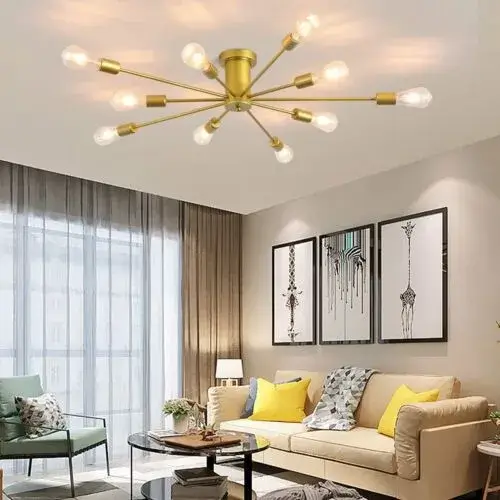If you are looking for a ceiling light that can illuminate your room with the most brightness, you might want to consider recessed lighting. Recessed lighting, also known as pot lights or can lights, are fixtures that are installed into the ceiling, creating a sleek and modern look. Recessed lighting can provide ample and even light distribution, as well as energy efficiency and versatility. In this article, we will explain why recessed lighting is the best option for maximizing the light output in your room, and how to choose and install the right recessed lights for your needs.
Benefits of Recessed Lighting
Recessed lighting has many advantages over other types of ceiling lights, such as flush mount, semi-flush mount, pendant, or chandelier lights. Here are some of the benefits of recessed lighting:
Brightness: Recessed lighting can produce more light than other types of ceiling lights, because they use multiple bulbs that are spaced evenly across the ceiling. This creates a uniform and bright illumination that can cover the entire room. Recessed lighting can also be dimmable, allowing you to adjust the light level according to your mood or preference.
Energy efficiency: Recessed lighting can save you money on your electricity bills, because they use LED bulbs that consume less energy and last longer than incandescent or halogen bulbs. LED bulbs also produce less heat, which can reduce the need for cooling in your room. Recessed lighting can also be compatible with smart home devices, such as timers, sensors, or voice assistants, that can automate the lighting and optimize the energy usage.
Versatility: Recessed lighting can suit any style and function of your room, because they come in various sizes, shapes, colors, and finishes. You can also choose different types of recessed lights, such as baffle, reflector, eyeball, gimbal, or shower lights, that can create different effects and atmospheres. Recessed lighting can also be used in different areas of your room, such as the ceiling, the walls, the floor, or the cabinets, to highlight or accentuate certain features or objects.
Space-saving: Recessed lighting can make your room look more spacious and open, because they do not take up any space on the ceiling or hang down from it. Recessed lighting can also create a sense of depth and dimension, by creating shadows and contrasts on the walls and the floor. Recessed lighting can also be ideal for rooms with low ceilings, where other types of ceiling lights might not fit or look good.
How to Choose and Install Recessed Lighting
If you are interested in installing recessed lighting in your room, there are some factors that you need to consider, such as the size, the number, the placement, and the wiring of the recessed lights. Here are some tips on how to choose and install recessed lighting:
Size: The size of the recessed lights depends on the size of your room and the height of your ceiling. Generally, the larger the room and the higher the ceiling, the larger the recessed lights should be. The most common sizes of recessed lights are 4 inches, 5 inches, and 6 inches in diameter, but you can also find smaller or larger ones depending on your preference. You should also consider the size of the trim, which is the visible part of the recessed light that surrounds the bulb. The trim can affect the appearance and the performance of the recessed light, so you should choose one that matches your style and your needs.
Number: The number of recessed lights depends on the amount of light that you want to achieve in your room. Generally, the more recessed lights you have, the brighter your room will be. However, you should also avoid overcrowding or overlighting your room, as this can create glare or discomfort. A good rule of thumb is to divide the square footage of your room by the wattage of each recessed light, and then round up to the nearest whole number. For example, if your room is 200 square feet and each recessed light is 10 watts, you should have 20 recessed lights (200 / 10 = 20).
Placement: The placement of the recessed lights depends on the layout and the function of your room. Generally, you should space the recessed lights evenly across the ceiling, leaving about 2 to 3 feet of space between each light and the wall. You should also align the recessed lights with the furniture or the focal points of your room, such as the sofa, the bed, the fireplace, or the artwork. You should also consider the direction and the angle of the recessed lights, especially if they are adjustable, to create the desired effect and mood in your room.
Wiring: The wiring of the recessed lights depends on the existing electrical system and the building codes of your home. Generally, you should consult a professional electrician before installing recessed lighting, as this can involve cutting holes in the ceiling, running wires through the attic or the basement, and connecting the recessed lights to a switch or a dimmer. You should also make sure that the recessed lights are compatible with the voltage and the circuit of your home, and that they are insulated and sealed properly to prevent fire hazards or moisture damage.
Conclusion
Recessed lighting is the best type of ceiling light that can give the most light in your room, as it can provide brightness, energy efficiency, versatility, and space-saving benefits. However, you should also consider the size, the number, the placement, and the wiring of the recessed lights, and seek professional help if necessary, to ensure a safe and successful installation. With recessed lighting, you can transform your room into a bright and beautiful space that you can enjoy and be proud of.

